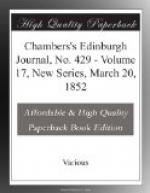The exports of manufactured goods from this country to all parts of the world is increasing weekly; but of all that another time, for I am carefully collecting information. One stand I would not omit, as it furnished evidence of the condition of the operatives. The exhibition is managed by the mechanics themselves, and the profits are devoted to the support of a mechanics’ institute, with the usual advantages of library, balls, and concerts, but of a very superior order; while every female who provides any article of her own production for exhibition and sale, has a free ticket admitting to all the advantages of the institution. This is found a useful stimulus, as the stand for those articles testified, consisting as they did of all descriptions of fancy-work: rugs, chair-bottoms, table-covers, tapestry, &c. produced in overhours, tasteful in design, and beautiful in execution. Let me not forget an invention, which is as great a boon to sufferers as the water-bed: it is a contrivance applied to an ordinary bedstead, which, by turning a handle, will support any part of the body, or place the body in any required position. It was the invention of a mechanic, who was nine months in bed in consequence of an accident, and felt the want of something of the kind. It is adapted to a bedstead at a cost of L.3.
From thence I went to the cattle-show. I could see but little of that, as most of the animals were gone; but I was assured it was very fine. I believe it, if what I saw was a specimen—a pair of working oxen, perfectly white, the pair weighing 7000 pounds. In our cattle-shows at home, we find plenty of bulk, but it destroys form and symmetry: here both were preserved. The fowls are of the long-legged Spanish breed, coming to table like trussed ostriches; the plump English barndoor sort are about being introduced. I had nearly forgotten a beautiful and extraordinary invention—a rifle, not heavier than the common one, that will discharge twenty-four balls in succession without reloading. Where the ramrod is usually placed, is a smaller barrel, containing, when filled, twenty-four ball-cartridges, and, after discharging, the action of recocking introduces another cartridge, and so on, until the whole are discharged; the whole twenty-four can be discharged in as many seconds!
After leaving this interesting exhibition, where I could have lingered a whole day, I was joined by a friend, an American—a gentleman of great attainments in science—to whose remarks I am indebted for the following scraps. The Merrimac, when low—as when I saw it—is a trifling stream, having a bottom of laminated rock, worn in channels by the stream. At spring and fall, there is ten or fifteen feet of depth; and to remedy this inequality, an important work was undertaken and executed: to this we bent our way. It is a canal in form, but should more properly be called a reservoir. It is 1-1/4 miles long, 100 feet wide, and 15 feet deep; of solid granite, sides and




